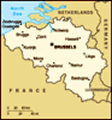Advertisement
Published: April 19th 2019
Ghent
After another night on the river, we woke up at the port of Ghent or Gent. I’ve seen it spelled both ways. Google prefers Gent in the English version, Ghent in Belgian. Going from the Netherlands to Belgium is a short trip but from the minute we got off the boat, there was a palpable difference that’s very hard to describe but I felt very good being in Belgium. It looked different. It sounded different. And the people were very, very, friendly though they didn’t all speak English like in the Netherlands. It seemed like the Belgians were much more like the French or Italians, loose and emotional, while the Dutch were more like the English, stiff (upper lip and the like) and proud. This is just me and those of you that have a lot of experience in Europe might think I’m dead wrong but since this is my blog, and you’re not paying to read this I’m free to share my bullshit opinions and you can agree with them, disagree, or choose to stop reading.
The old city of Ghent is gorgeous, with the original port and four large cathedrals, all dating from the 15
th, 16
th and 17
th centuries. Fran and I walked all over in the morning. The town is full of fresh baked breads and pastries. We finally succumbed to a very high carbohydrate snack, a Belgian Waffle. As my niece, Emily, now a mom and much more mature, would have said in years past, OMG. The sign in the window said “our waffles don’t need any toppings.” That sign was just irresistible. It was not fake advertising. It was sweet and savory at the same time, like a donut that wasn’t greasy. It was sweet but not that sweet. It was deceptively light. Fran and I split one and decide to forgo lunch. One should not go to Belgium and not try a waffle.
We walked on and made it to the Gravensteen Castle of Phillip of Alsace. The Castle was built in the 12
th century, pre-Renaissance, during a period referred to as the 12
th Century Revival. Europe was just coming out of the dark ages and this was an early structure built entirely of stone – no wood. Stone was expensive. It needed quarries, diggers, and transport. For wood you needed saws. So building this castle was a big deal, paid
for by serfs for this wonderful guy, Count Phillip. Among other innovations in this castle was indoor plumbing. The toilet was cantilevered out over the protective moat. It was on the second story and consisted of an 8-inch hole in the stone. Poop would drop directly into the moat below. Lore has it that Phillip’s subjects would line the moat when Phillip was on the throne and cheer loudly when a turd hit the water. If that wasn’t enough, the castle had torture rooms and all manner of torture devices, as Phillip was not satisfied with just pooping in the moat. These devices are on display. Fran wanted to exit within three minutes of entering but I forced a quick tour. The guidebooks say this is a don’t miss visit. Fran disagrees.
Now on the skipping lunch thing; didn’t work out. The restaurants in town seemed to be all full or closed. It is Easter week and schools are out, businesses are on vacation and tourists are plentiful. This is a tough combination for people that are looking for better than fast food or touristy Brasseries in town. After a quick and very good lunch on our ship we
went on another tour, first by bus and then on foot (no buses or cars allowed in the center of town – nice) with one main goal, to see the Ghent altarpiece created by Jan and Hubert van Eyck. Finished in 1432, it is a magnificent, probably the most magnificent piece(s) of early northern Renaissance art. It’s famous for many reasons but it was brought to popular culture in the movie Monuments Men, starring George Clooney, where, in 1945, he finds this work hidden in a salt mine in Austria. There are or were 24 panels, all but one saved. One remains missing. As opposed the castle, this IS a don’t miss experience. The tour took us to St. Bave’s chapel where first we saw a magnificent Reubens in the church and then, in a small chapel, we saw some, but not all of the panels. A major, much needed restoration of the work is underway. Some of it is completed and we could see those in the chapel alongside photocopies of the ones under restoration. Then, after seeing some in the chapel, we went to the Museum of Fine Arts where we were shown the restoration process and the
panels they were working on and a conservator explained it all. Here is where the guide was essential. No way we could have gotten that much on our own. It was terrific. We got back at about 6:30 and Debussy departed at 7 for an overnight to Antwerp. Fran took a nap before dinner. This was a great day; a combination of organized tours and individual exploring. I think we’re getting the hang of it.
Advertisement
Tot: 0.186s; Tpl: 0.016s; cc: 15; qc: 55; dbt: 0.0628s; 1; m:domysql w:travelblog (10.17.0.13); sld: 1;
; mem: 1.2mb









Tom Drum
non-member comment
Great History Lesson
Thanks for sharing insight into your trip. It reminds me of the Kaleidescope toy when I was growing up. I realize how much of the world I am ignorant of, and how we need to get around the world more. Please keep up the GREAT writing!!